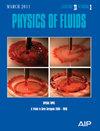Heterogeneity properties and permeability of shale matrix at nano-scale and micron-scale
IF 4.3
2区 工程技术
Q1 MECHANICS
引用次数: 0
Abstract
Heterogeneity of shale pores at nano-scale and micrometer-scale is of great significance to gas transport properties. In this study, the pore structure of shale samples from lower Silurian Longmaxi Formation in the Sichuan basin is investigated by field emission-scanning electron microscopy (FE-SEM) and x-ray micro-computed tomography (Xμ-CT) technology. Based on fractal theory, the lacunarity is introduced to describe the clustering degree of pores in shale matrix, which can compensate for the limitations of fractal dimension. Combining lacunarity with fractal dimension allows for quantification of subtle differences in pore spatial distribution. For FE-SEM images at nano-scales, the fractal dimension changes in a “U” shape, while lacunarity changes in a “∩” shape. For Xμ-CT images at micrometer-scale, both the fractal dimension and lacunarity change in a logarithmic function. Lacunarity at both nano-scale and micrometer-scale linearly decreases with the increase in fractal dimension. By three-dimensional (3D) pore network modeling analysis, the structure properties of the connected pores, such as the number of pores and throats, pore diameter, pore volume, pore surface, throat length, and coordination number, are quantitatively calculated, and these structure parameters show strong heterogeneity. The average coordination number of the connected pores ranges in 2.92–4.36. This indicates that these pores in shale matrix have poor connectivity. The permeability varies from 0.06 to 0.17 μm2 in two-dimensional (2D) Xμ-CT images but from 3.20 to 34.99 μm2 in a 3D structure. The permeability in the 3D structure is about two order higher in magnitude than that in the 2D Xμ-CT images.页岩基质在纳米和微米尺度上的异质性和渗透性
页岩孔隙在纳米尺度和微米尺度上的异质性对气体输送特性具有重要意义。本研究采用场发射扫描电子显微镜(FE-SEM)和X射线微计算机断层扫描(Xμ-CT)技术研究了四川盆地下志留统龙马溪地层页岩样品的孔隙结构。以分形理论为基础,引入裂隙度来描述页岩基质中孔隙的聚集程度,弥补了分形维度的局限性。将裂隙度与分形维度相结合,可以量化孔隙空间分布的细微差别。对于纳米尺度的 FE-SEM 图像,分形维度呈 "U "形变化,而裂隙度呈"∩"形变化。对于微米尺度的 Xμ-CT 图像,分形维度和裂隙度都呈对数函数变化。纳米尺度和微米尺度的裂隙度随着分形维度的增加而线性降低。通过三维孔隙网络建模分析,定量计算了连通孔隙的结构特性,如孔隙和孔道数、孔隙直径、孔隙体积、孔隙表面、孔道长度和配位数等,这些结构参数表现出很强的异质性。相连孔隙的平均配位数在 2.92-4.36 之间。这表明页岩基质中的这些孔隙连通性较差。在二维(2D)Xμ-CT 图像中,渗透率从 0.06 到 0.17 μm2 不等,但在三维结构中,渗透率从 3.20 到 34.99 μm2 不等。三维结构中的渗透率比二维 Xμ-CT 图像中的渗透率高出约两个数量级。
本文章由计算机程序翻译,如有差异,请以英文原文为准。
求助全文
约1分钟内获得全文
求助全文
来源期刊

Physics of Fluids
物理-力学
CiteScore
6.50
自引率
41.30%
发文量
2063
审稿时长
2.6 months
期刊介绍:
Physics of Fluids (PoF) is a preeminent journal devoted to publishing original theoretical, computational, and experimental contributions to the understanding of the dynamics of gases, liquids, and complex or multiphase fluids. Topics published in PoF are diverse and reflect the most important subjects in fluid dynamics, including, but not limited to:
-Acoustics
-Aerospace and aeronautical flow
-Astrophysical flow
-Biofluid mechanics
-Cavitation and cavitating flows
-Combustion flows
-Complex fluids
-Compressible flow
-Computational fluid dynamics
-Contact lines
-Continuum mechanics
-Convection
-Cryogenic flow
-Droplets
-Electrical and magnetic effects in fluid flow
-Foam, bubble, and film mechanics
-Flow control
-Flow instability and transition
-Flow orientation and anisotropy
-Flows with other transport phenomena
-Flows with complex boundary conditions
-Flow visualization
-Fluid mechanics
-Fluid physical properties
-Fluid–structure interactions
-Free surface flows
-Geophysical flow
-Interfacial flow
-Knudsen flow
-Laminar flow
-Liquid crystals
-Mathematics of fluids
-Micro- and nanofluid mechanics
-Mixing
-Molecular theory
-Nanofluidics
-Particulate, multiphase, and granular flow
-Processing flows
-Relativistic fluid mechanics
-Rotating flows
-Shock wave phenomena
-Soft matter
-Stratified flows
-Supercritical fluids
-Superfluidity
-Thermodynamics of flow systems
-Transonic flow
-Turbulent flow
-Viscous and non-Newtonian flow
-Viscoelasticity
-Vortex dynamics
-Waves
 求助内容:
求助内容: 应助结果提醒方式:
应助结果提醒方式:


